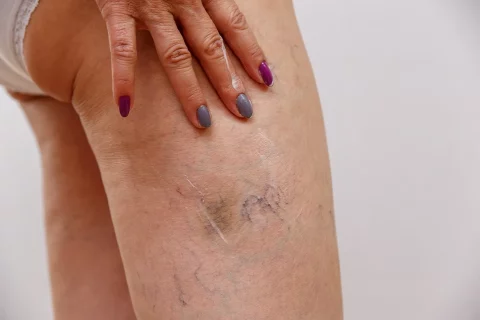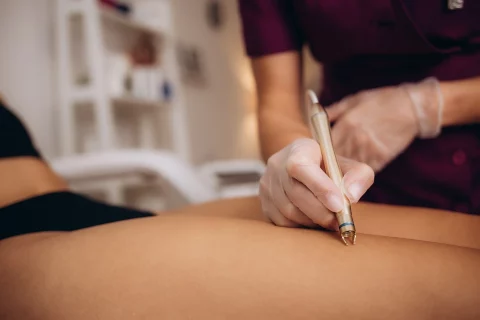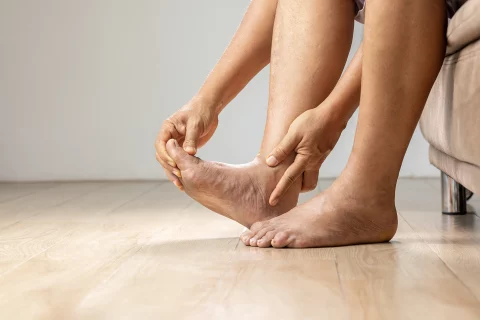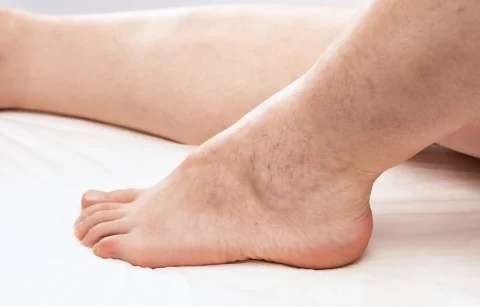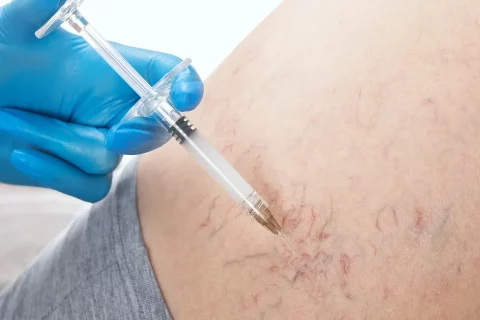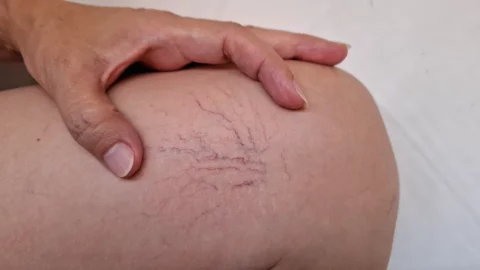
When a nurse documents bluish spider veins observed during a skin assessment, they use the term ‘telangiectasia.’
This term is crucial for precise medical records and communication among healthcare professionals. It identifies the specific type of vein and its coloration.
Understanding and using ‘telangiectasia‘ ensures accurate and effective patient care.
What are Bluish Spider Veins?
Bluish spider veins, also known as telangiectasias, indicate possible circulatory problems due to venous insufficiency.
This condition causes valves in veins to malfunction, leading to symptoms like discomfort and swelling.
What Causes Bluish Spider Veins?
Telangiectasias (bluish spider veins) can be caused by genetics, sun exposure, aging, and certain medical conditions. Genetic predisposition can make some individuals more susceptible to developing these visible blood vessels.
Prolonged sun exposure to harmful UV rays can damage the skin and blood vessels, leading to their dilation and visibility.
The natural aging process weakens blood vessel walls, making them more prone to dilation.
Medical conditions like rosacea and autoimmune diseases can also contribute to the development of telangiectasias.
How are Bluish Spider Veins Diagnosed?
Bluish Spider Veins, or Telangiectasias, are commonly diagnosed through a physical examination by a medical professional.
Tests may also be used to help diagnose or rule out underlying conditions that could be causing the telangiectasias. These tests may include blood tests, imaging scans like MRI or CT scans, or biopsies of the affected tissue.
Genetic testing can also help diagnose hereditary conditions like Hereditary hemorrhagic telangiectasia (HHT) that cause telangiectasias if a gene mutation is detected.
The diagnosis is made based on identifying the characteristic skin lesions along with evaluating any related symptoms or family history of similar issues.
Spider Veins on Nose
Telangiectasias on the nose, also known as nasal telangiectasias, are very common. They appear as small, dilated blood vessels visible on the surface of the nose.
Some key facts about nasal telangiectasias:
- They are caused by an abnormal widening or dilation of tiny blood vessels near the surface of the skin.
- Nosebleeds are a common symptom, as the fragile telangiectatic vessels can rupture easily with minor trauma.
- Nasal telangiectasias are often associated with a condition called hereditary hemorrhagic telangiectasia (HHT), where multiple telangiectasias form throughout the body.
- Treatment options include laser therapy, cauterization, sclerotherapy, or medications to help strengthen blood vessels and reduce bleeding risk.
- More severe or widespread nasal telangiectasias can significantly impact quality of life due to frequent epistaxis (nosebleeds).
Can Bluish Spider Veins Be a Sign of a Serious Health Condition?
Yes, bluish spider veins or telangiectasias can sometimes be a sign of a more serious underlying health condition.
While many telangiectasias are benign and do not cause any symptoms, some sources indicate that telangiectasias can bleed and cause significant problems.
One serious condition that telangiectasias can indicate is hereditary hemorrhagic telangiectasia (HHT), which is a genetic disorder that causes weakened blood vessels. HHT can lead to problems like severe nosebleeds, strokes, bleeding in the digestive tract, and anemia if left untreated.
Are Bluish Spider Veins More Common as I Get Older? What Can I Do?
Yes, bluish spider veins or Telangiectasias tend to become more common as people get older. Aging blood vessels can begin to weaken, which can lead to the formation of telangiectasias
Telangiectasias occur most frequently in the eyes, in particular in the conjunctiva, and/or in sun-exposed areas of the skin as people age.
Some things you can do to avoid bluish spider veins:
- Use sunscreen daily to protect skin from UV damage, which is a risk factor for developing telangiectasias.
- See a dermatologist if telangiectasias appear on your skin. They may be able to treat them depending on the cause.
- Manage any underlying conditions like rosacea that are linked to an increased risk of telangiectasias.
Will Telangiectasias Go Away on Their Own?
No, some causes of telangiectasia will not resolve and require treatment. Some will develop some type of venous insufficiency, whether it is in the form of spider veins or varicose veins. They can persist and worsen over time if left untreated.
Spider Veins vs Telangiectasias
The terms spider veins and telangiectasias are often used interchangeably to refer to the same type of small, dilated blood vessels close to the skin’s surface.
Spider veins and telangiectasias are most commonly found on the legs. They appear as blue, red, or purple lines or branches under the skin. Spider veins and telangiectasias are caused by damage or weakness in the tiny veins that carry blood from the legs back to the heart.
While spider veins and telangiectasias may cause some cosmetic concerns, they are generally harmless. However, in some cases they can be associated with underlying medical conditions.
Telangiectasias Treatment Options

To treat telangiectasias, you can consult a dermatologist to discuss treatment options such as laser therapy, sclerotherapy, and intense pulsed light (IPL) therapy.
Laser therapy uses targeted light energy to fade the affected blood vessels, while sclerotherapy involves injecting a solution to shrink and eliminate the vessels.
IPL therapy uses broad-spectrum light to reduce the appearance of telangiectasias.
Each option has its own considerations and potential side effects, so it’s important to consult with a dermatologist to determine the most suitable treatment for your specific condition.
Laser vs Sclerotherapy for Facial Telangiectasias
Laser therapy and sclerotherapy are both commonly used treatments for facial telangiectasias.
- Laser surgery and sclerotherapy are specifically mentioned as treatment modalities for facial telangiectasias that can achieve a higher clearance rate.
- Nd:YAG laser is recommended for small telangiectasias under 1 mm in diameter, while sclerotherapy with polidocanol is more efficient for larger ones.
- Laser therapy is used for telangiectasias in patients with veins of a diameter less than a 30 gauge needle.
- Long lasting skin hypopigmentation can result from laser treatment.
Both laser therapy and sclerotherapy have proven effective for treating facial telangiectasias, though lasers may be better suited for very small vessels and sclerotherapy for larger ones.
The choice depends on the individual patient and vessel characteristics.
Will Laser Treatment for Telangiectasias Leave Scars?
Laser treatment for telangiectasias can potentially leave scars, but the risk of scarring depends on the type of laser used and size of the telangiectasias.
Laser light can destroy the vein without damaging your skin, so small spider veins may disappear immediately after treatment with no scarring.
However, larger veins treated with laser are more likely to leave minimal scarring or damage to the surrounding area. Pulsed dye laser is the gold standard of treatment for spider telangiectasias and provides good clearance rates with minimal risk of scarring.
In some cases, laser resurfacing may even be used to treat scars left by previous laser treatments.
Telangiectasias After Rosacea Treatment
Several treatments have shown effectiveness in treating telangiectasias that develop after rosacea, including:
- Pulsed dye laser
- Intense pulsed light
- Near infrared lasers
- Brimonidine gel
- Oxymetazoline cream combined with PDL
Does Alcohol Worsen Telangiectasias?
Alcohol consumption can worsen telangiectasias. It is a risk factor or trigger for telangiectasias. Specifically:
- Alcohol abuse is associated with facial redness and telangiectasia due to enlarged blood vessels
- Activities that trigger blushing or facial redness like alcohol consumption can worsen telangiectasia
- Vascular disturbances associated with alcohol misuse include telangiectasias
- Daily consumption of 30 to 50 grams of alcohol for over five years can cause alcoholic liver disease which is associated with telangiectasias
- Telangiectasias are found in conditions like alcoholic liver disease
- Alcohol misuse can cause ataxia which may present with telangiectasia
- Alcohol can affect the flow of blood in vessels and cause liver disease, both of which are risk factors for telangiectasias
Tips for Managing Telangiectasias
Telangiectasias can be managed effectively by protecting the skin from sun exposure, maintaining a healthy lifestyle, and considering cosmetic treatments such as laser therapy or sclerotherapy.
Sunscreen, protective clothing, and seeking shade reduce UV damage. A balanced diet, regular exercise, and not smoking contribute to skin health.
Makeup Tips for Covering Telangiectasias

Here are some makeup tips for covering telangiectasias:
- Use a flesh-toned cover-up or concealer that matches your skin tone to immediately hide mild telangiectasias.
- Apply the cover-up or concealer last, after completing the rest of your makeup routine. This helps seal the coverage.
- Set your makeup with a setting spray to prevent the coverage from fading throughout the day.
- Reapply cover-up or concealer as needed if you notice the telangiectasias becoming visible again.
In addition to makeup, using probiotic supplements containing lactobacillus strains may help reduce rosacea flare-ups and visibility of telangiectasias long-term.


